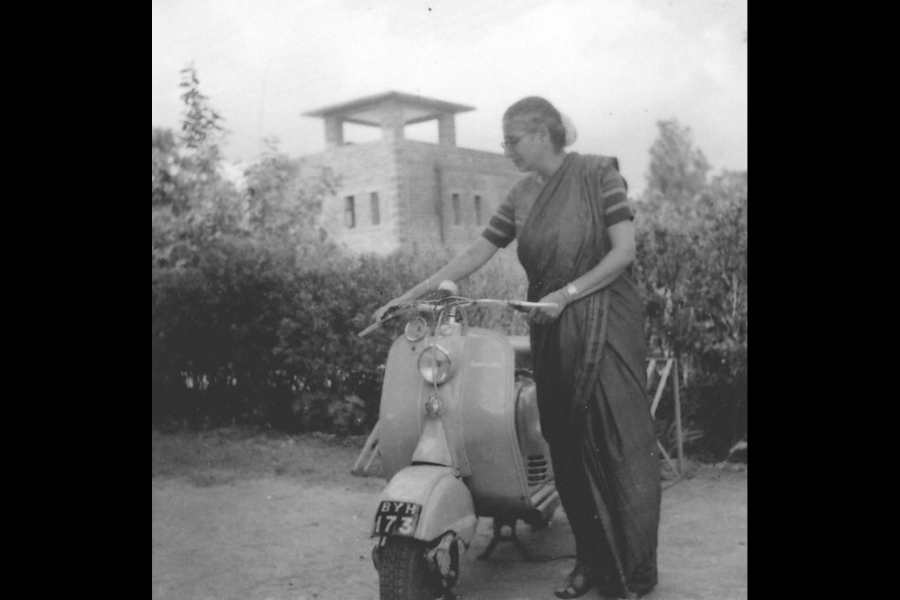Book: IRU : THE REMARKABLE LIFE OF IRAWATI KARVE
Author: Urmilla Deshpande and Thiago Pinto Barbosa
Published by: Speaking Tiger
Price: Rs 699
Co-written by Urmilla Deshpande and Thiago Pinto Barbosa, this book is part memoir of a grandmother and part intellectual biography of a pioneering Indian sociologist and anthropologist. The book is divided into sixteen chapters under four parts. Parts 2 and 3 give a chronological narrative of Irawati Karve’s life and work. It is prefaced in Part 1 by her defining doctoral years in Berlin where she mustered the extraordinary courage of proving the theory of her supervisor, Dr Eugen Fischer — that of the superiority of the European race over people of colour based on the measurement of their skulls — wrong.
Karve’s lifelong commitment to learning and her pioneering work in the fields of anthropology and sociology can be contextualised in terms of her relationship with the men in her life. Born in 1905 in Myingyan in Burma in a prosperous household and doted on as the youngest child and only daughter in the family, Irawati was sent — in a very unconventional move — to boarding school in Pune by her father, Ganesh Hari Karmarkar. Her mother, Bhagirathi, missed her terribly. Soon after, she was adopted into the family of R.P. Paranjpye and his wife, Saitai, where her education was encouraged above everything else. Her marriage to Dinkar Karve, the second son of one of Paranjpye’s cousins, Annah Karve, was a strategic one — meant to ensure further studies given that Annah was a champion of women’s rights (especially of widows). Ganesh Karmarkar had different ideas about Irawati’s future, but Bhagirathi supported the match.
The three fathers in her life notwithstanding, it was her husband (whom she called ‘Dinu’) who was her rock — right from the time they married young till her untimely death in 1970. Though his presence is felt throughout the book, the chapter that is dedicated to him and is one of the most memorable is “Grihasti Parva”. Two things stand out about the man as husband and father. First, he encouraged Iru to go to Berlin for her PhD in the teeth of strong opposition from both her father and (shockingly) his own; second, he did not mind the separation of several years that it would entail. He joined her towards the end of her stay for a belated honeymoon in Europe. During the voyage back home, they embroidered a tablecloth together. That tablecloth could be taken as the emblem of their relationship: something they worked at as equal partners through all the vicissitudes of their lives. Particularly notable (given the times) was his involvement in the rearing of their three children — Jai, Anand and Gauri — and the sharing of domestic responsibilities. That was the factor that most helped her during her regular research trips to many parts of India during semester breaks. After Berlin, this support was most crucial in her year-long stay at SOAS (“East and West of the Thames”) where she wrote her most influential book, Kinship Organization in India (1968).
Another man who was an important part of Karve’s work was Hasmukh Dhirajlal Sankalia, her colleague at the Deccan College, Pune. They not only worked at the same institution but also did many field trips together. “Paleolith and Microlith” pays homage to this relationship, giving one of the longest quotes from her Marathi essay, “Paripurti” (1949), while recounting an archaeological expedition of theirs in a village in south Gujarat.
This and the other chapters in Part 3 trace the trajectory of Karve’s increasingly diverse work after her PhD — from her anthropometric research, which helped support the creation of the state of Maharashtra, to explorations of the consequences of development projects (such as “A Survey of the People Displaced through the Koyna Dam”, 1969). It is, however, her Sahitya Akademi award-winning book, Yuganta: The End of an Epoch (1967), a critical study of the Mahabharata, that echoes as a refrain throughout the book, both in the context of her work and her personal relationships.
It is interesting that Irawati had fraught relationships with some of the closest women in her life — her adoptive mother, mother-in-law, and especially her younger daughter, Gauri, who became an acclaimed feminist writer in Marathi. This book, in a way, effects a reconciliation between the two through Gauri’s daughter, Urmilla.











